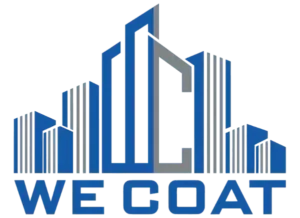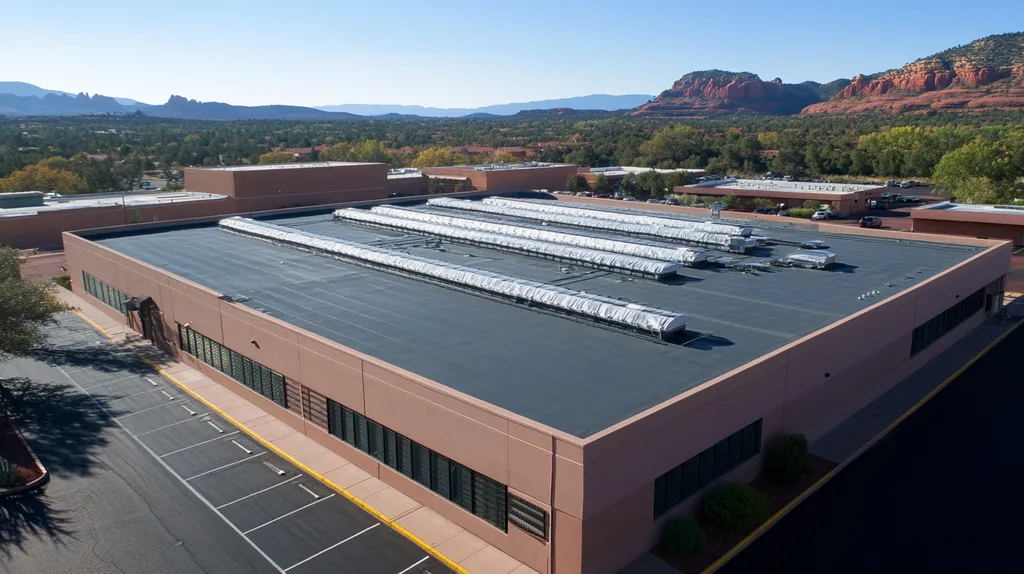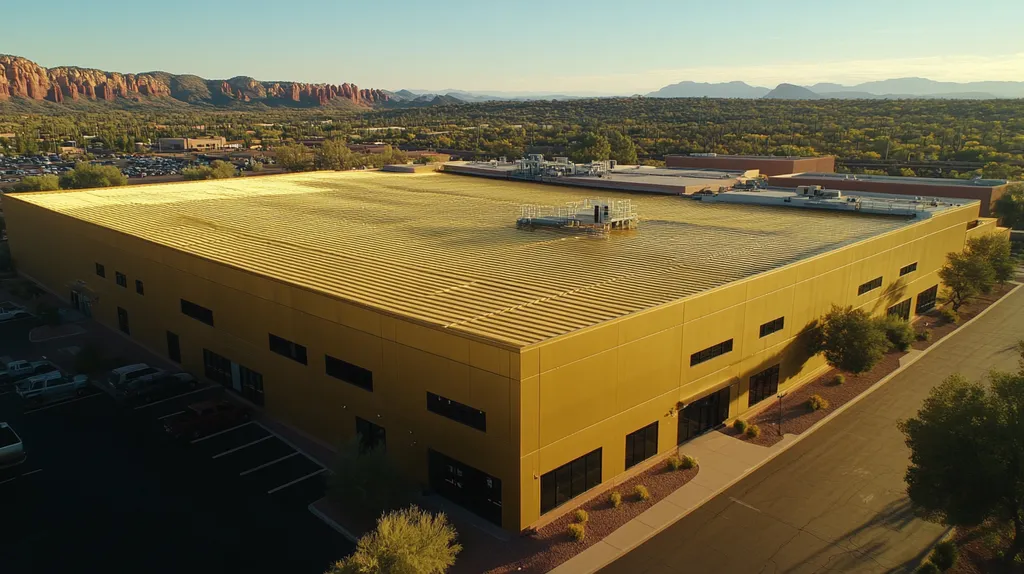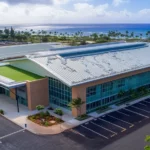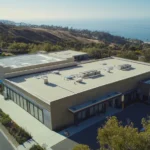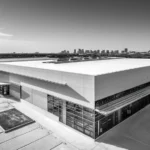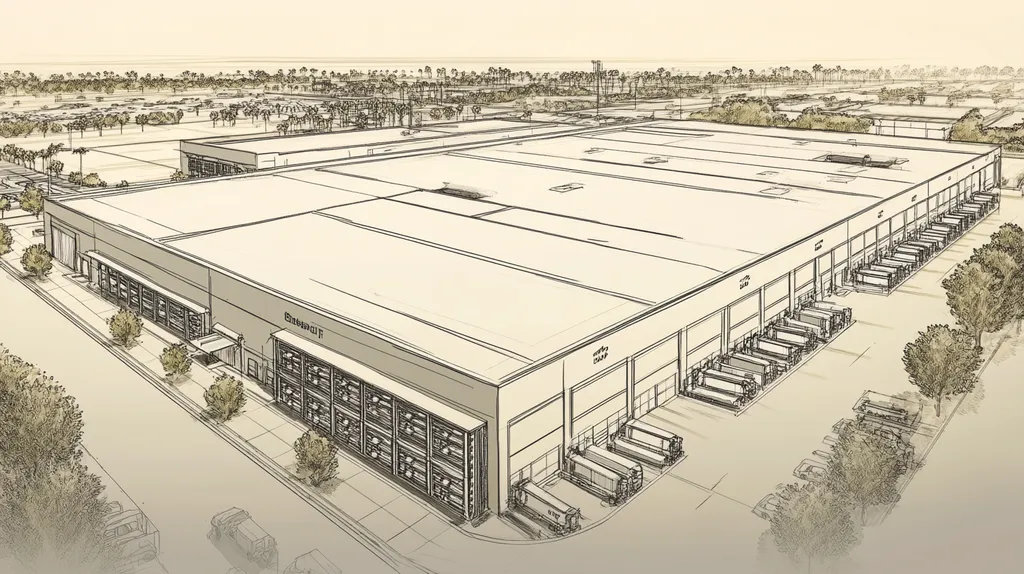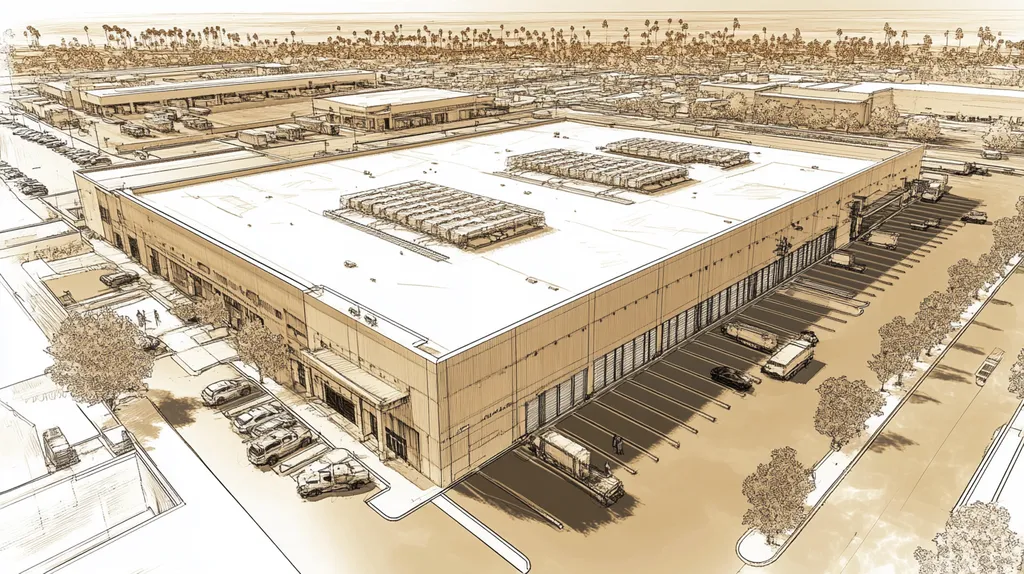Every year, commercial property owners lose millions in energy costs and repairs due to poorly selected or improperly applied roof coatings. While 87% of building managers understand the importance of roof protection, only 35% know how to choose the right coating for their specific needs.
The stakes are particularly high when comparing coating options for flat versus sloped commercial roofs, as each presents unique challenges that demand tailored solutions.
From extending roof life by up to 25 years to slashing cooling costs by 30%, the right coating choice can dramatically impact a building’s bottom line. This comprehensive guide breaks down everything property owners need to know about selecting, applying, and maintaining optimal roof coatings for both flat and sloped commercial structures.
SECTION 1: FUNDAMENTAL CONCEPTS
Understanding roof coatings is essential for ensuring the longevity and optimal performance of commercial roofs. Did you know that over 75% of flat roofs show signs of wear within just a decade? Making the right coating choice can dramatically impact maintenance costs and boost energy efficiency. This section will delve into the fascinating history and evolution of roof coatings, explore the various types currently available, and highlight the key benefits they offer to property owners.
History and Evolution of Roof Coatings
Roof coatings have come a long way, evolving in response to technological innovations and shifting market demands. Initially, these coatings were mainly composed of asphalt and tar, focused primarily on waterproofing flat roofs.
As the years went by, manufacturers began developing advanced membranes and coatings that provided enhanced durability and better resistance to damaging UV rays. By the late 20th century, as energy efficiency gained importance, reflective coatings surfaced to help mitigate heat absorption.
Today, coatings incorporate cutting-edge materials like silicone and polyurethanes, suitable for both flat and sloped roofs. These modern innovations not only extend the lifespan of roofs but also contribute to lower energy expenses for commercial properties.
Each new generation of roof coatings not only aims to protect but also to improve the overall efficiency of roofing systems, promoting sustainable building practices and minimizing environmental impact.
Types of Commercial Roof Coatings
There are several types of commercial roof coatings, each designed to meet the specific needs of different roofing systems and varying climate conditions. Acrylic coatings are widely favored for their versatility and moisture resistance, making them suitable for numerous applications.
Silicone coatings shine when it comes to weather resistance, particularly for flat roofs, as they effectively repel water. They serve as a seamless layer of protection, extending the lifespan of existing roofs.
Polyurethane coatings are celebrated for their durability and resistance to chemicals, making them ideal for roofs that face heavy foot traffic or industrial exposure.
Additionally, EPDM and TPO coatings are commonly utilized for their reflective properties, which are optimized for energy savings. Knowing these options empowers property owners to make informed choices tailored to their specific roofing requirements.
Key Benefits and Advantages
Roof coatings bring a wealth of benefits that can significantly enhance a building’s operational efficiency. One of the primary highlights is their ability to extend roof lifespan, reducing the necessity for expensive replacements.
Moreover, coatings dramatically improve energy efficiency by reflecting sunlight, effectively lowering cooling costs during the warmer months. For instance, roofs treated with reflective materials can slash energy consumption by as much as 30%.
In addition to energy savings, roof coatings simplify maintenance and repair processes. They can seal minor leaks and cracks, preventing escalating damage before full-scale repairs become necessary.
Finally, investing in roof coatings aligns with sustainability goals. As property owners increasingly strive for greener practices, adopting these effective solutions reduces material waste and energy consumption, positively benefiting the environment.
SECTION 2: SYSTEM COMPONENTS
The choice of coating materials for a commercial roof can dramatically impact its lifespan and performance. In fact, roofs treated with high-quality coatings can see energy costs slashed by thousands each year. Understanding the various types of coatings available isn’t just smart—it’s essential for protecting investments and promoting environmental sustainability.
Acrylic, Silicone, and Polyurethane Coatings
Acrylic coatings are water-based solutions that shine when it comes to UV protection. They’re commonly applied to both flat and sloped roofs due to their user-friendly application. Property owners often opt for acrylic coatings because they bounce back from the sun’s rays, significantly lowering cooling costs during those sweltering summer months.
In contrast, silicone coatings are superheroes of waterproofing. Perfect for regions that frequently face heavy rain or snow, these coatings maintain their stretchiness over time, delivering robust protection against harsh weather. Talk about peace of mind!
On the durability front, polyurethane coatings reign supreme, making them perfect for rooftops facing heavy foot traffic or exposure to chemicals. They create a strong, seamless defense that can withstand daily wear and tear, ideal for industrial facilities constantly on the move.
Each coating type has distinct perks, so it’s crucial to consider the specific needs of the roof when choosing a product. Tailoring the coating to the roof’s requirements ensures optimal protection while maximizing the system’s lifespan.
Asphalt Emulsion and PMMA Coatings
Asphalt emulsion coatings offer a wallet-friendly approach to roof restoration. They create a thick, protective layer over existing roofs, sealing small flaws and enhancing their ability to fend off the weather. Perfect for property owners on a budget, these coatings are not only easy to apply but can also breathe new life into aging rooftops.
Meanwhile, PMMA (Poly-Methyl Methacrylate) coatings shine when speed is of the essence. These fast-curing options are ideal for those urgent repairs that can’t wait. Bursting with durability and UV resistance, PMMA coatings ensure longevity even in the harshest of climates.
Both asphalt emulsion and PMMA coatings offer versatility across various substrates, boosting overall roof performance. Choosing the ideal coating material tailored to the specific environmental conditions can make all the difference in effectiveness.
Coating Materials and Formulations
The coating formulations are vital to performance. High-quality materials enhance adhesion, flexibility, and longevity. Roofers typically recommend paying attention to the solid content percentage in the coatings, as higher solid content often results in superior performance.
Compatibility with existing roofing materials is another critical aspect. If a coating struggles to adhere to certain surfaces, it can lead to premature failures. Consulting with professional roofers can guide property owners in selecting materials compatible with their specific roof type and conditions.
Besides performance, environmentally-friendly formulations are gaining popularity. These coatings minimize hazardous emissions, making them safer for applicators and occupants alike. Striking the right balance between effectiveness and environmental responsibility can help property owners make sustainable decisions.
Ultimately, selecting the right coating involves careful consideration of unique needs and available options. Seeking professional advice ensures optimal results, yielding value and longevity for the roofing system.
SECTION 3: IMPLEMENTATION METHODS
When it comes to roofing coatings, the implementation methods used can mean the difference between a roof that lasts and one that quickly deteriorates. Poor execution can lead to costly repairs—studies suggest that inadequate preparation can inflate repair costs by over 20% of total installation expenses. To safeguard their investments, building owners and facility managers must grasp the intricacies of each implementation stage.
Inspection and Preparation Procedures
Before any coatings can find their way onto a roof, a comprehensive inspection is crucial. Spotting existing damage or troublesome areas allows for focused repairs, significantly boosting adhesion. For example, roofs suffering from moisture accumulation or surface degradation must be addressed before coating can commence.
It’s also essential to evaluate the roof’s substrate, ensuring it’s clean and debris-free. Techniques like power washing or using specialized cleaning products can eliminate dirt, algae, and other contaminants. A dry and well-prepared surface sets the stage for a successful coating application.
Moreover, confirming the compatibility of existing roofing materials with the intended coatings is vital. Different materials may respond differently to specific coatings, which can affect performance and longevity. Consulting a roofing specialist ensures the perfect match for optimal results.
Lastly, all inspections should adhere to industry standards and local regulations. Keeping a proper record of inspections and preparation work helps establish a clear history, beneficial for future maintenance or warranty claims.
Application Techniques and Tools
The technique and tools chosen for applying roofing coatings must align with the roof type—flat or sloped. On flat roofs, spray application is often preferred for its efficiency, allowing for even distribution across large areas. Conversely, sloped roofs may be better served by brush or roller applications, ensuring effective penetration and adhesion.
Equipment selection—including airless sprayers, rollers, and brushes—should be tailored to the specific coating used. Choosing the right nozzle size during spray applications helps prevent overspray, ensuring a uniform coat. Adhering to the manufacturer’s guidelines for application rates and methods is essential.
Environmental conditions can also affect the success of the application. Monitoring temperature and humidity is crucial for optimal curing, and it’s best to apply coatings in weather that allows for proper drying, ideally avoiding direct sunlight or rain.
Finally, ensuring technicians are well-trained in best practices for applying coatings safely minimizes the risk of errors, which could lead to expensive rework down the line.
Safety and Environmental Considerations
Safety and environmental concerns are paramount during the application of roofing coatings. Exposure to potentially hazardous materials can pose risks to both workers and building occupants. Utilizing personal protective equipment (PPE)—including gloves, goggles, and respirators—becomes essential to safeguard everyone involved.
Additionally, considering the environmental impact of chosen coatings is vital. Opting for products with low volatile organic compounds (VOCs) contributes to healthier air quality around the site. Many modern coatings provide eco-friendly alternatives without compromising performance.
Effective waste management during and after the application is also crucial. All materials must be disposed of in accordance with local regulations to avoid environmental contamination. Implementing these best practices fosters a more sustainable roofing project.
In summary, understanding safety procedures, environmental considerations, and proper disposal is critical for any roofing project. Careful preparation not only protects the job site but also reinforces the long-term integrity of the roof itself.
SECTION 4: MAINTENANCE REQUIREMENTS
Regular maintenance of a roofing system is not just a choice; it’s a necessity that determines the roof’s longevity and overall effectiveness. Failing to maintain a roof can lead to costly water damage and structural issues, with repairs potentially costing up to 20 times more than routine upkeep. This section will outline essential maintenance practices for both flat and sloped roofs, covering the crucial areas of inspections, cleaning protocols, and reapplication strategies.
Regular Inspection and Repair Needs
Routine inspections are the first line of defense against roof failure. Property owners should schedule at least bi-annual inspections, especially after severe weather events, to catch issues early. These inspections can reveal wear, punctures, or leaks, potentially saving thousands in repairs down the road.
Flat roofs require particular attention due to their tendency to pool water. Trained professionals should evaluate drainage systems and membrane integrity to thwart long-term damage. While sloped roofs manage runoff more effectively, they can still develop issues that demand timely attention.
Quick repairs following inspections are essential, particularly on flat roofs prone to rapid deterioration from standing water. Using compatible materials during repairs helps ensure the longevity of fixes and prevents recurring issues down the track.
Creating a documented maintenance plan that includes an inspection schedule and necessary repairs enhances both the roof’s lifespan and the efficiency of budgeting for maintenance expenses.
Cleaning and Surface Preparation
Cleaning is crucial to the effectiveness of roofing coatings. Accumulated debris, moss, and algae can undermine surface performance, particularly on flat roofs that easily gather dirt and moisture. Regular cleanings keep roofs functioning at their best.
Property managers should use non-abrasive solutions when cleaning to avoid damaging the roofing materials. In some cases, pressure washing can help, but it must be applied carefully to prevent harm. Understanding the cleaning needs of flat versus sloped roofs is fundamental to selecting the right methods.
Before reapplying coatings, surfaces must be dry, clean, and free from contaminants. Addressing existing damages ensures that new coatings adhere optimally, enhancing performance for years to come.
Investing time in cleaning and preparing surfaces is essential for maximizing the effectiveness of coatings, contributing to a sustainable roofing system.
Reapplication and Renewal Strategies
Coatings typically require reapplication every 5 to 10 years, depending on wear and environmental conditions. Flat roofs may need more frequent attention to maintain their integrity. Planning for these renewals can help avoid unexpected shutdowns and costly repairs.
Selecting high-quality coatings that are compatible with existing materials is critical during reapplication. Consulting roofing professionals can help property owners choose the right products, ensuring effective moisture barriers and UV protection.
Timing the reapplication is equally important. Applying coatings during mild weather conditions increases the chances for a successful layer bond, minimizing disruption for building occupants and daily operations.
A well-structured maintenance schedule that includes timely reapplication significantly boosts the roof’s performance and lifespan, ultimately enhancing property value and protecting investments going forward.
SECTION 5: PERFORMANCE METRICS
Selecting the right roofing coating isn’t just a choice; it’s a pivotal decision that can make or break a commercial property’s budget and integrity. The right coating can dramatically enhance energy efficiency, bolster durability, and provide essential waterproofing. On the flip side, ill-suited coatings can skyrocket energy costs and lead to expensive repairs. In this section, the focus is on the key performance metrics that matter most to property owners—energy efficiency, durability, and elemental protection.
Energy Efficiency and Cost Savings
Energy efficiency is a top priority for commercial roofs. High-quality coatings can reflect sunlight and minimize heat absorption, slashing air conditioning costs. For example, some reflective white coatings can lower roof temperatures by as much as 40 degrees Fahrenheit, translating into substantial savings on energy bills.
Furthermore, a reduced energy demand not only extends the lifespan of HVAC systems but also decreases the costs associated with replacements and maintenance. With the right coatings, property owners can often see a solid return on investment within just a few years, effectively balancing the initial expenditure.
The types of coatings available vary greatly in their effectiveness. Flat roofs tend to thrive with elastomeric coatings, renowned for their superior reflective qualities, while sloped roofs may benefit more from mineral-based coatings that offer both efficiency and aesthetic appeal.
By prioritizing energy efficiency metrics when selecting coatings, property owners can cut operational costs and contribute to more sustainable building practices.
Durability and Longevity Standards
Durability is a crucial metric that cannot be overlooked when evaluating roofing coatings. A robust coating should endure harsh weather and physical wear over time. For example, premium polyurethane coatings can boast lifespans of up to 20 years, while lower-grade alternatives may fail far sooner, costing you in repairs and replacements.
Flat roofs, in particular, face challenges like standing water, which can lead to premature coating deterioration. Choosing a coating with a high elongation rate allows for expansion and contraction, ensuring it can adapt to the building’s movement without cracking.
Sloped roofs experience different challenges, such as debris accumulation and snow load. A coating designed to combat these elements, along with built-in UV resistance, can dramatically enhance its longevity and overall performance.
Investing in durable coatings also means fewer maintenance visits and lower long-term costs, promoting a healthier lifecycle for the roofing system.
Waterproofing and UV Protection
Waterproofing is a non-negotiable feature for any commercial roof to fend off leaks and moisture-related damage. A well-designed coating can form an effective barrier against water penetration. Liquid-applied coatings, for example, create seamless membranes that are especially effective on flat roofs prone to water pooling.
Equally essential is UV protection, especially for roofs that face prolonged exposure to sunlight. Coatings with high UV resistance mitigate the effects of thermal expansion and contraction, preserving the integrity of the roof and extending its life.
Choosing a coating with both waterproofing and UV protection is a smart strategy that safeguards the roofing materials and enhances the safety of the building’s interior. This cost-effective approach can save property owners from unexpected repairs and costly downtime.
In summary, understanding the waterproofing capabilities and UV protection features of roofing coatings is crucial for informed decision-making that aligns with long-term investment goals.
SECTION 5: PERFORMANCE METRICS
Selecting the right roofing coating is not just about aesthetics or cost; it’s a crucial decision that directly impacts a commercial property’s budget and overall integrity. Choosing an effective coating can dramatically boost energy efficiency, enhance durability, and provide essential waterproofing. Conversely, a poor selection can lead to skyrocketing energy bills and costly repairs. This section dives into the performance metrics that matter most for property owners—energy efficiency, durability, and protection against the elements.
Energy Efficiency and Cost Savings
Energy efficiency stands at the forefront of concerns for any commercial roofing system. The right coatings can effectively reflect sunlight and minimize heat absorption, which translates directly into lower air conditioning costs. For example, certain reflective coatings can reduce roof temperatures by as much as 40 degrees Fahrenheit—an impressive figure that results in substantial savings on energy bills.
Moreover, a decrease in energy consumption extends the lifespan of HVAC systems, which in turn cuts down on replacement and maintenance expenses. By making an informed coating choice, property owners often see a favorable return on investment within just a few years, effectively offsetting their initial costs.
The effectiveness of coatings varies significantly. Flat roofs, for instance, significantly benefit from elastomeric coatings known for their superior reflective properties, while sloped roofs often shine with mineral-based coatings that offer both energy efficiency and a pleasing appearance.
Ultimately, prioritizing energy efficiency metrics when selecting coatings not only reduces operational costs but also supports environmentally sustainable building practices, making a significant difference for both the pocketbook and the planet.
Durability and Longevity Standards
Durability and longevity can’t be overlooked when evaluating roofing coatings. A quality coating should resist the challenges posed by harsh weather conditions and daily wear and tear. Premium polyurethane coatings can last up to 20 years, whereas lower-grade options might fail after just a few short years, leading to potential expenses that could have been avoided.
Flat roofs are particularly vulnerable to standing water, which can lead to premature coating failure. Choosing a coating with a high elongation rate is essential as it allows the material to expand and contract with the building’s movements without cracking, ensuring consistent roof integrity.
On the other hand, sloped roofs face different obstacles like debris buildup and snow loads. A well-designed coating that includes features to combat these issues significantly enhances longevity and performance. Coatings with built-in UV resistance also play a critical role in maintaining durability by shielding the material from degradation.
Investing in durable coatings not only reduces the need for frequent maintenance but also lowers long-term costs, ultimately promoting a healthier lifecycle for the roofing system itself.
Waterproofing and UV Protection
Waterproofing remains a non-negotiable requirement for commercial roofs to prevent leaks and moisture-related damage. A well-crafted coating can serve as an effective barrier against water infiltration. For example, liquid-applied coatings create seamless membranes, which work exceptionally well on flat roofs prone to water pooling.
Equally vital is UV protection, especially for roofs exposed to direct sunlight. Coatings that boast strong UV resistance can help diminish the risks associated with thermal expansion and contraction, safeguarding the structural integrity of both flat and sloped roofs.
Selecting a coating that offers both waterproofing and UV protection ensures the longevity of the roofing materials and adds an extra layer of safety for the building’s interior. This strategic choice can save property owners from unexpected repairs and the disruptions they bring.
In summary, understanding the waterproofing capabilities and UV protection features of roofing coatings is essential for property owners aiming to make informed decisions that align with their long-term investment goals.
The Bottom Line
With commercial roofing costs reaching an all-time high and energy efficiency demands increasing yearly, selecting the right coating system has never been more critical for property owners.
While flat roofs benefit most from seamless membranes and reflective coatings that combat ponding water, sloped roofs require specialized formulations focusing on adhesion and UV protection.
The data speaks volumes: properly selected and maintained roof coatings can extend roof life by 25 years while reducing cooling costs by up to 30%.
As environmental regulations tighten and energy costs continue to rise, investing in appropriate coating solutions isn’t just smart business—it’s essential for long-term property management success.
The future of commercial roofing lies in these innovative coating technologies, making today’s informed decisions crucial for tomorrow’s building performance.
FREQUENTLY ASKED QUESTIONS
Q. What are commercial roof coatings and why are they important?
A. Commercial roof coatings protect and extend the life of roofing systems. They improve energy efficiency and prevent premature damage by reflecting UV rays and sealing minor leaks, helping to minimize costly repairs.
Q. What type of coatings are best for an industrial roof?
A. Industrial roofs benefit from durable coatings like polyurethane and silicone. These types offer excellent protection against heavy foot traffic and harsh weather conditions, enhancing longevity and performance for facilities with demanding environments.
Q. How often should I inspect my commercial roof?
A. It’s recommended to inspect your commercial roof at least twice a year. Additional inspections after severe weather can catch issues early, saving you from costly repairs down the line.
Q. How can I improve energy efficiency in my commercial roof?
A. Energy efficiency can be improved by applying reflective coatings. These coatings minimize heat absorption, keeping roof temperatures down and reducing air conditioning costs significantly throughout hotter months.
Q. What maintenance is required for roof coatings?
A. Regular maintenance includes inspections for damage, cleaning debris, and timely reapplication of coatings. This helps ensure that your roofing system functions optimally, preventing leaks and extending the roof’s lifespan.
Q. Are there eco-friendly options for commercial roofing coatings?
A. Yes! Many brands offer eco-friendly coatings that contain low volatile organic compounds (VOCs). These help improve air quality while still providing effective protection and durability for your roof.
Q. What factors influence the lifespan of a commercial roof coating?
A. Factors include the type of coating, local climate conditions, and the quality of installation. Regular maintenance and prompt repairs will also significantly enhance the coating’s longevity and overall performance.
